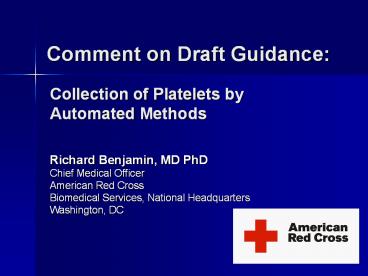Comment on Draft Guidance: - PowerPoint PPT Presentation
1 / 14
Title:
Comment on Draft Guidance:
Description:
Apheresis process validation for bacterial contamination ... Positive cultures are common but rarely indicate apheresis process failure. ... – PowerPoint PPT presentation
Number of Views:71
Avg rating:3.0/5.0
Title: Comment on Draft Guidance:
1
Comment on Draft Guidance
Collection of Platelets by Automated Methods
Richard Benjamin, MD PhD Chief Medical Officer
American Red Cross Biomedical Services, National
Headquarters Washington, DC
2
Items for discussion
- Apheresis process validation for bacterial
contamination - Duration of medication deferral for platelet
inhibitors - Number of platelet components collected per year
3
Product Performance Qualification (Component
Collection)
- You should use the following collection
performance qualification criteria - Test a minimum of 60 consecutive single (30 for
double and 20 for triple) collections for each
type of automated blood cell separator for (1)
actual platelet yield, pH, volume, visible RBCs
and (2) for residual WBC count and percent
recovery (Ref. 2), with 0 failures in each
category. Perform bacterial contamination
testing on 500 collections with 0 failures. Refer
to Table 1.
4
Issue SummaryTopic II. Public Comments on
Guidance for Industry and FDA Review Staff
Collection of Platelets by Automated Methods
(Draft)
- Item 1 Process Validation for Bacterial Safety
- ..One element of process validation is the
determination qualification of the product
integrity, which includes bacterial testing to
ensure adequacy of an aseptic process for blood
collection and component processing. FDAs draft
guidance recommended that that process validation
for microbial safety should include culture-based
testing of 500 consecutive collections for
bacterial contamination, with no more than one
positive test result. The rationale for this
sample size is to assure with gt95 confidence
that the true bacterial contamination rate is
less than 1. Based on published literature (ref
1), the bacterial contamination rate for a
conforming process should not exceed 13,000. At
this level, the proposed validation test would be
expected to yield a false result of
non-conformance in fewer than 3 of
determinations.
5
BacT/ALERT Bacterial Detection System
6
Positive Bacterial Cultures using BacT/Alert
Methods of Failure(n 350,840 1/1/05
-010/31/05)
- Total positive 1 1,519
- False positives
- Contamination at inoculation 1 2,580
- BacT/ALERT incubator failure
- Apheresis kit contamination/integrity 0
- Donor bacteremia
- Phlebotomy 15,012
- (Skin plug/site preparation)
Failure is not due to failure of the Apheresis
equipment or process. In most cases root cause
of true positives (ie donor bacteremia vs
incomplete skin preparation) cannot be
determined. Proof that true contamination rate
is lt1 has no medical significance.
Fang CT et al Transfusion 2005, 451485
7
Recommendation
- Conclusions
- Positive cultures are common but rarely indicate
apheresis process failure. - 100 QC is in place to ensure product sterility
and confirm process integrity - 500 cultures will unduly delay licensure of
products - Suggested 1 cutoff has no medical significance
- Criteria are not applied to other variables
(Yield, pH, volume, WBC count, RBC content) - Bacterial cultures should be performed on 60
consecutive products to prove process integrity,
in keeping with other required parameters.
8
ASA 5 day deferral
- Not supported by available evidence
- Inconsistent with current AABB Standard
- Current deferral period of 36 hours is supported
by published reports and expected recovery of
platelet function
9
Platelet Function in Recipients of Platelets from
Donors Ingesting Aspirin.Stuart et al. New Eng J
Med 287 1105-1109, 1972
Prolonged bleeding times were corrected to normal
in recipients of platelets from donors who had
taken ASA 36 hours before donation
10
NSAIDS 3 day deferral
- NSAIDs are common 5 to 10 of the adult US
population, or 15 million to 25 million people,
use an NSAID on a regular basis. - Commonly used NSAIDS have short half-lives
- Platelet function normalizes within 24 hours of
cessation of regular ibuprofen use in healthy
individuals (Goldenberg et al. Ann Intern Med
2005 142506-509. - Commonly used NSAIDS
- Reversible inhibition
- Modest bleeding time abnormalities which usually
do not exceed the upper limit of normal - Dose-dependent effect dilution after
transfusion with recovery of platelet function
11
Number of components/year
The yearly change in platelet counts in regular
donors, regardless of their frequency of
donation, is distributed around a mean decrease
of 3,900/uL per year, which is a clinically
insiginificant difference
12
Number of components/yr
- Impact on availability loss of 35,786 products
from high-frequency, high yield donors ( 6 of
distributable inventory) - No evidence that donors who gave more than 24
components per year are at greater risk of
significant changes in platelet counts than those
who give fewer than 24 components/yr
13
Impact on supply
- If the component number, physician-on-site, NSAID
deferral, and volume loss limitations were
implemented. - Loss of 65,000 Platelet, Apheresis components
per year - 40 million additional cost
- No evidence that these changes would increase
donor or patient safety.
14
ARC Recommendations
- Process validation for bacterial safety
- Modify to 60 consecutive negative cultures
instead of 500 - Deferrals for platelet inhibitors
- ASA 36 hour deferral supported by data
- NSAIDS Eliminate requirement for 3 d deferral
- Number of platelet components per year
- Do not impose additional restrictions
- Appropriate safeguards are already in place to
prevent collection of a donor with an
unacceptable platelet count































